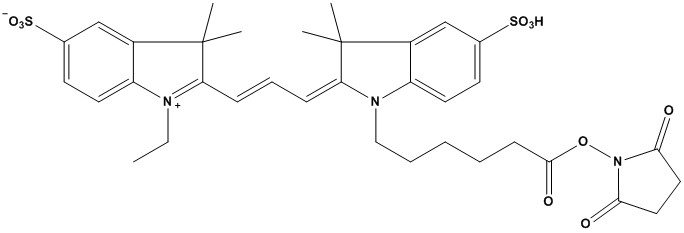| Synonyms: | Equivalent of Cy3 NHS Ester |
| CAS #: | 146368-16-3 |
| Molecular Formula: | C35H41N3O10S2 |
| Molecular Weight: | 727.8 |
| Cy3 (Cyanine 3) is a powerful and popular synthetic polymethine dye that has become a workhorse in molecular biology and cellular imaging. It is part of the extensive family of Cy dyes, which were originally developed for fluorescence applications and are now available in a wide variety of reactive forms. Cy3 is particularly valued for its bright, orange-red fluorescence and its compatibility with standard laboratory equipment. 1. Key Spectral and Chemical Properties The effectiveness of Cy3 is rooted in its well-defined and stable physical properties, which make it predictable and reliable for a wide range of experiments. 1.1 Spectral Characteristics • Excitation Maximum (λex): Approximately 550 nm. This places its optimal excitation in the green-yellow part of the spectrum. It is efficiently excited by a 543 nm Helium-Neon laser or a 532 nm diode laser, which are common in fluorescence microscopes and flow cytometers. • Emission Maximum (λem): Approximately 570 nm. This results in a distinct orange-red emission, which is easily detected and spectrally separated from green dyes like FITC (Fluorescein) and far-red dyes like Cy5. 1.2 Molar Extinction Coefficient (ϵ) Cy3 has a high molar extinction coefficient of around 1.5×105 M−1cm−1, which indicates that it is highly efficient at absorbing light at its excitation wavelength. 1.3 Quantum Yield (Φ) With a quantum yield of approximately 0.31, Cy3 is considered a moderately bright fluorophore. This means that for every 100 photons it absorbs, it emits about 31 photons. 1.4 Photostability Cy3 exhibits good photostability, meaning it can withstand repeated light exposure for a reasonable amount of time before photobleaching occurs. While not as stable as some of the most advanced fluorophores, it is generally sufficient for most imaging and detection protocols. 2. Primary Applications The versatility of Cy3 is evident in the breadth of its applications across numerous biological disciplines. • Fluorescence Microscopy and Cell Imaging: Cy3 is one of the most common dyes used in immunostaining and fluorescent labeling. Researchers conjugate Cy3 to secondary antibodies to visualize specific proteins or cellular structures. Its orange-red emission is often paired with a green fluorophore (like FITC or Alexa Fluor 488) and a far-red fluorophore (like Cy5 or Alexa Fluor 647) for three-color imaging experiments. • DNA and RNA Labeling: Cy3-labeled oligonucleotides are routinely used for techniques like Fluorescence In Situ Hybridization (FISH) to visualize specific nucleic acid sequences within cells or tissues. It is also a staple in microarray technology, where it is used to label cDNA from a sample to be hybridized with a chip, allowing for the quantification of gene expression. • Fluorescence Resonance Energy Transfer (FRET): Cy3 can act as an effective FRET donor when paired with a suitable acceptor, such as Cy5. This pairing is widely used to measure molecular proximity and dynamic interactions in real-time, such as protein-protein binding or conformational changes. • Flow Cytometry: Conjugated antibodies labeled with Cy3 are used to identify and quantify specific cell populations in flow cytometry experiments. The dye’s excitation and emission profile is well-suited for many commercial flow cytometers. 3. Advantages of Using Cy3 Researchers often choose Cy3 for several compelling reasons: • Spectral Separation: Cy3’s excitation and emission profiles are well-separated from those of other commonly used dyes (e.g., FITC/Alexa 488 and Cy5/Alexa 647). This makes it an ideal choice for multiplexed experiments, where multiple targets need to be visualized simultaneously without significant spectral crosstalk. • Broad Compatibility: Its spectral properties align with widely available laser and filter sets, minimizing the need for specialized equipment. This makes it an accessible and cost-effective option for many labs. • Ease of Conjugation: Cy3 is available in various reactive forms, such as N-hydroxysuccinimide (NHS) esters for labeling primary amines and maleimides for labeling thiols. This makes it relatively easy to conjugate to a wide range of biomolecules, including antibodies, proteins, and nucleic acids. 4. Limitations and Considerations While highly effective, Cy3 is not without its limitations: • Photobleaching: While its photostability is good, it is still susceptible to photobleaching, especially under intense laser illumination over long periods. This can be a concern for long-term time-lapse microscopy. • Environmental Sensitivity: The fluorescence intensity of Cy3 can be sensitive to its local environment, particularly pH and hydrophobicity. This means that its brightness can vary depending on where it is located within a cell or molecule, which can complicate quantitative analysis. • Comparison to Next-Generation Dyes: In recent years, newer dyes, such as the Alexa Fluor series, have been developed that offer superior photostability and brighter fluorescence. For some demanding applications, these newer dyes may be a better choice. However, Cy3 remains a more affordable and widely used alternative for a vast number of research applications. Cy3 stands as a cornerstone of fluorescent labeling in modern biological research. Its excellent brightness, convenient spectral properties for multicolor experiments, and ease of use have cemented its status as a reliable and accessible tool. While newer dyes may offer advantages in specific high-demand applications, Cy3 remains a foundational component of many a researcher’s toolkit, especially for its cost-effectiveness and broad compatibility. It continues to be a staple for imaging, flow cytometry, and nucleic acid detection, making it an indispensable part of the life sciences landscape. References: 1. Overview of Fluorescent Dyes 2. Cyanine 3. Dye Directory 4. Cy3 Dye Profile |
|
Cyanine 3, SE
For Research & Development use only. Not for testing and/or use on humans.



